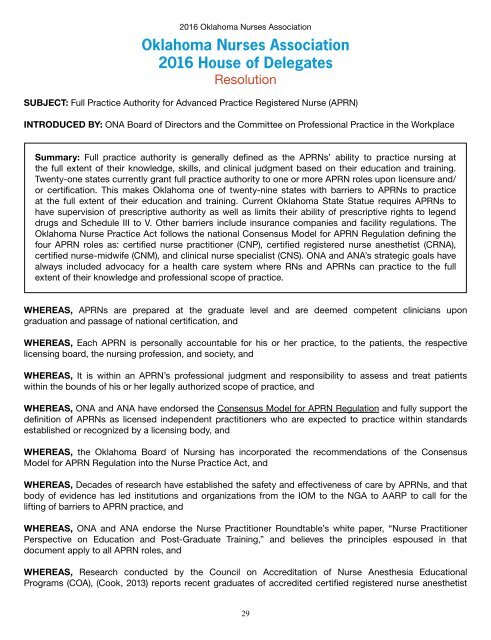2016 Oklahoma Annual Book of Reports
You also want an ePaper? Increase the reach of your titles
YUMPU automatically turns print PDFs into web optimized ePapers that Google loves.
<strong>2016</strong> <strong>Oklahoma</strong> Nurses Association<br />
<strong>Oklahoma</strong> Nurses Association<br />
<strong>2016</strong> House <strong>of</strong> Delegates<br />
Resolution<br />
SUBJECT: Full Practice Authority for Advanced Practice Registered Nurse (APRN)<br />
INTRODUCED BY: ONA Board <strong>of</strong> Directors and the Committee on Pr<strong>of</strong>essional Practice in the Workplace<br />
Summary: Full practice authority is generally defined as the APRNs’ ability to practice nursing at<br />
the full extent <strong>of</strong> their knowledge, skills, and clinical judgment based on their education and training.<br />
Twenty-one states currently grant full practice authority to one or more APRN roles upon licensure and/<br />
or certification. This makes <strong>Oklahoma</strong> one <strong>of</strong> twenty-nine states with barriers to APRNs to practice<br />
at the full extent <strong>of</strong> their education and training. Current <strong>Oklahoma</strong> State Statue requires APRNs to<br />
have supervision <strong>of</strong> prescriptive authority as well as limits their ability <strong>of</strong> prescriptive rights to legend<br />
drugs and Schedule III to V. Other barriers include insurance companies and facility regulations. The<br />
<strong>Oklahoma</strong> Nurse Practice Act follows the national Consensus Model for APRN Regulation defining the<br />
four APRN roles as: certified nurse practitioner (CNP), certified registered nurse anesthetist (CRNA),<br />
certified nurse-midwife (CNM), and clinical nurse specialist (CNS). ONA and ANA’s strategic goals have<br />
always included advocacy for a health care system where RNs and APRNs can practice to the full<br />
extent <strong>of</strong> their knowledge and pr<strong>of</strong>essional scope <strong>of</strong> practice.<br />
WHEREAS, APRNs are prepared at the graduate level and are deemed competent clinicians upon<br />
graduation and passage <strong>of</strong> national certification, and<br />
WHEREAS, Each APRN is personally accountable for his or her practice, to the patients, the respective<br />
licensing board, the nursing pr<strong>of</strong>ession, and society, and<br />
WHEREAS, It is within an APRN’s pr<strong>of</strong>essional judgment and responsibility to assess and treat patients<br />
within the bounds <strong>of</strong> his or her legally authorized scope <strong>of</strong> practice, and<br />
WHEREAS, ONA and ANA have endorsed the Consensus Model for APRN Regulation and fully support the<br />
definition <strong>of</strong> APRNs as licensed independent practitioners who are expected to practice within standards<br />
established or recognized by a licensing body, and<br />
WHEREAS, the <strong>Oklahoma</strong> Board <strong>of</strong> Nursing has incorporated the recommendations <strong>of</strong> the Consensus<br />
Model for APRN Regulation into the Nurse Practice Act, and<br />
WHEREAS, Decades <strong>of</strong> research have established the safety and effectiveness <strong>of</strong> care by APRNs, and that<br />
body <strong>of</strong> evidence has led institutions and organizations from the IOM to the NGA to AARP to call for the<br />
lifting <strong>of</strong> barriers to APRN practice, and<br />
WHEREAS, ONA and ANA endorse the Nurse Practitioner Roundtable’s white paper, “Nurse Practitioner<br />
Perspective on Education and Post-Graduate Training,” and believes the principles espoused in that<br />
document apply to all APRN roles, and<br />
WHEREAS, Research conducted by the Council on Accreditation <strong>of</strong> Nurse Anesthesia Educational<br />
Programs (COA), (Cook, 2013) reports recent graduates <strong>of</strong> accredited certified registered nurse anesthetist<br />
29

















